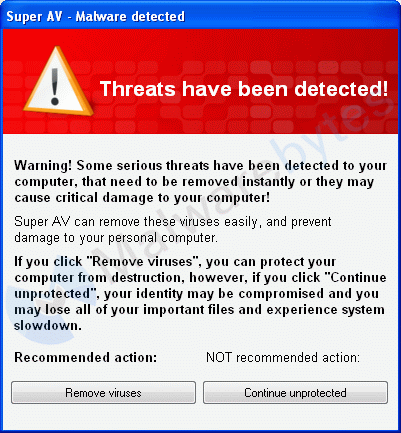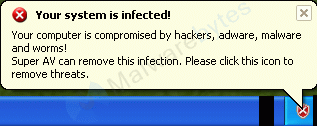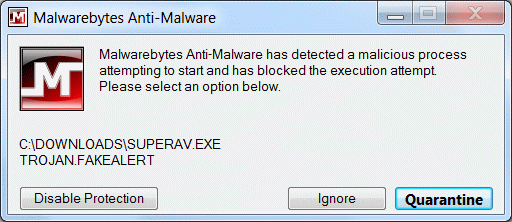What is Super AV?
The Malwarebytes research team has determined that Super AV is a fake anti-malware application. These so-called "rogues" use intentional false positives to convince users that their systems have been compromised. Then they try to sell you their software, claiming it will remove these threats. In extreme cases the false threats are actually the very trojans that advertise or even directly install the rogue. You are strongly advised to follow our removal instructions below.
How do I know if I am infected with Super AV?
This is how the main screen of the rogue application looks:

You will find these icons alternating in your taskbar:
And see these warnings:



How did Super AV get on my computer?
Rogue programs use different methods for spreading themselves. This particular one was installed by a trojan.
How do I remove Super AV?
Our program Malwarebytes' Anti-Malware can detect and remove this rogue application.
- Please download Malwarebytes' Anti-Malware to your desktop.
- Double-click mbam-setup.exe and follow the prompts to install the program.
- At the end, be sure a check-mark is placed next to the following:
- Update Malwarebytes' Anti-Malware
- Launch Malwarebytes' Anti-Malware
- Then click Finish.
- If an update is found, it will download and install the latest version.
- Once the program has loaded, select Perform quick scan, then click Scan.
- When the scan is complete, click OK, then Show Results to view the results.
- Be sure that everything is checked, and click Remove Selected. Reboot your computer if prompted.
- When completed, a log will open in Notepad. The rogue application should now be gone.
Is there anything else I need to do to get rid of Super AV?
- No, Malwarebytes' Anti-Malware removes Super AV completely.
How would the full version of Malwarebytes' Anti-Malware help protect me?
We hope our application has helped you eradicate this malicious software. If your current security solution let this infection through, you might please consider purchasing the FULL version of Malwarebytes' Anti-Malware for additional protection.
As you can see below the full version of Malwarebytes' Anti-Malware would have protected you against the Super AV rogue. It would have warned you before the rogue could install itself, giving you a chance to stop it before it became too late.

Signs in a HijackThis log:
C:\Documents and Settings\{username}\Desktop\superav.exe
C:\Windows\rpvvnxoc.exe
O4 - HKLM\..\Run: [Security] C:\Windows\rpvvnxoc.exe
Note: the filename is random
Alterations made by the installer:
File System
===============
In the existing folder C:\WINDOWS
Adds the file rpvvnxoc.exe"="18:28 27/12/11 1034752 bytes
Registry
===============
[HKEY_LOCAL_MACHINE\SOFTWARE\Microsoft\Windows\CurrentVersion\Run]
"Security"="'C:\Windows\rpvvnxoc.exe'"
[HKEY_LOCAL_MACHINE\SOFTWARE\Microsoft\Windows NT\CurrentVersion\Image File Execution Options\taskmgr.exe]
"Debugger"="C:\xhergjui.exe"
Malwarebytes' Anti-Malware log:
Malwarebytes Anti-Malware 1.60.0.1800
www.malwarebytes.org
Database version: v2011.12.31.03
Windows XP Service Pack 3 x86 NTFS
Internet Explorer 8.0.6001.18702
{username} :: MBAM-D3E8C91ACC [administrator]
12/31/2011 1:19:18 PM
mbam-log-2011-12-31 (13-19-18).txt
Scan type: Quick scan
Scan options enabled: Memory | Startup | Registry | File System | Heuristics/Extra | Heuristics/Shuriken | PUP | PUM
Scan options disabled: P2P
Objects scanned: 147249
Time elapsed: 1 minute(s), 12 second(s)
Memory Processes Detected: 1
C:\Documents and Settings\{username}\Desktop\superav.exe (Trojan.FakeAlert) -> 1744 -> Delete on reboot.
Memory Modules Detected: 0
(No malicious items detected)
Registry Keys Detected: 1
HKLM\SOFTWARE\MICROSOFT\WINDOWS NT\CURRENTVERSION\IMAGE FILE EXECUTION OPTIONS\TASKMGR.EXE (Hijack.Debugger.TM) -> Quarantined and deleted successfully.
Registry Values Detected: 2
HKLM\SOFTWARE\Microsoft\Windows\CurrentVersion\Run|Security (Trojan.FakeAlert) -> Data: C:\Windows\rpvvnxoc.exe -> Quarantined and deleted successfully.
HKLM\SOFTWARE\Microsoft\Windows NT\CurrentVersion\Image File Execution Options\taskmgr.exe|Debugger (Hijack.Debugger.TM) -> Data: C:\xhergjui.exe -> Quarantined and deleted successfully.
Registry Data Items Detected: 0
(No malicious items detected)
Folders Detected: 0
(No malicious items detected)
Files Detected: 2
C:\Documents and Settings\{username}\Desktop\superav.exe (Trojan.FakeAlert) -> Delete on reboot.
C:\WINDOWS\rpvvnxoc.exe (Trojan.FakeAlert) -> Quarantined and deleted successfully.
(end)
As mentioned before the full version of Malwarebytes' Anti-Malware could have protected your computer against this threat.
We use different ways of protecting your computer(s):
- Dynamically Blocks Malware Sites & Servers
- Malware Execution Prevention








 Back to top
Back to top





 Sign In
Sign In Create Account
Create Account

